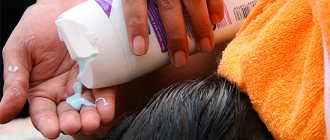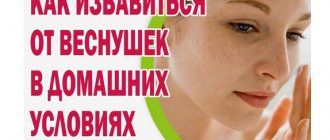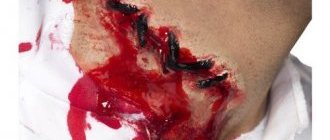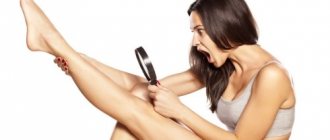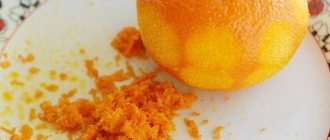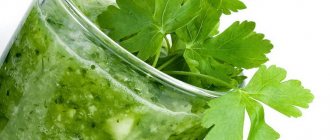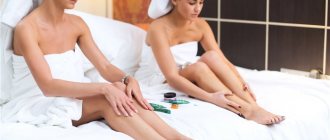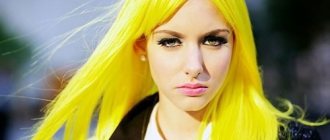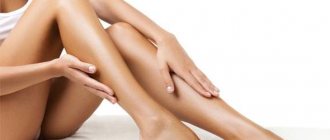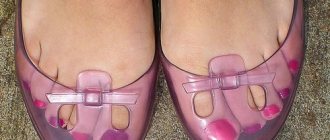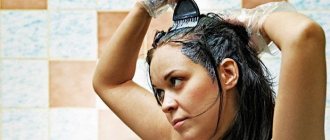An alarm bell that may indicate the presence of pediculosis can be constant itching of the scalp (especially the occipital region).
The most accurate answer to the question of whether there are lice in your hair can be given by a fine-tooth comb and a regular sheet of white paper. You need to bend your head over the paper laid out on the table and, using a comb, carefully comb your hair, strand by strand.
What remains on the paper after the procedure must be carefully examined, preferably with a magnifying glass. This way you can verify the absence or presence of lice. You should also carefully examine your hair for the presence of nits. Nits are lice eggs that females attach to the hair using a special adhesive secretion they produce. You cannot shake nits off your hair, just as you cannot remove them by regular shampooing.
What to do if a child gets head lice?
The question of how to remove lice from children is very often asked on forums for parents. Such interest in the problem is far from accidental, because every year, especially from the beginning of August to the end of September, there is a peak in lice infection, as evidenced by doctors.
If lice are found in a child, then there is no need to blindly follow the advice given on various forums, since this or that product (for example, the well-known kerosene) can cause an allergy in the child, lead to skin lesions and serious health consequences. You should not experiment with folk remedies, many of which are far from safe for children. They will not always be able to help the child, but they can harm the child quite easily. It is best to consult with a specialist who will help you choose the most effective and at the same time gentle remedy for treating your child.
Advice!
Sometimes the most effective way to get rid of lice in children is to cut their hair short, because it is much easier to remove insects from short hair.
How to get rid of lice nits?
Despite the fact that a person today has access to a variety of means to maintain both personal hygiene and cleanliness in his home, lice or lice is a fairly common disease. The question of how to remove lice nits can arise in anyone, even in the most clean and tidy family.
Have you been trying to get rid of PARASITES for many years?
Head of the Institute: “You will be amazed at how easy it is to get rid of parasites by taking every day...
Read more "
Who are lice and nits
Lice are called ectoparasites, which are blood-sucking insects and parasitize on any mammal; nits are their larvae. Researchers have discovered more than five hundred species of these parasites. The main feature of an ectoparasite is that its life activity can occur only on one type of host.
The insects, their larvae and eggs cause a disease called pediculosis in humans or other mammals. Its general features are:
- Unpleasant itching in the area of the bites.
- Bite marks.
- Blue spots on the skin from bites.
- Allergic reaction to bites.
The disease is contracted through skin-to-skin contact with sick people.
In order to cure the disease, you need to study information on how to get rid of larvae and lice eggs and how to kill lice eggs.
Pediculosis itself can be treated quite well, with timely detection of parasites and proper treatment. The danger is that lice are carriers of diseases such as typhus and relapsing fever, as well as Volyn fever. These diseases can cause serious complications. Therefore, pediculosis must be treated. In addition, lice in the hair give a person an overall unkempt and unkempt appearance and are also highly contagious.
You can pick up lice in places where there are large crowds of people, in public baths and swimming pools, using other people's personal belongings, especially combs, hairpins, and hair ties.
Two types of lice can parasitize a person - pubic and human lice, which in turn has two subspecies - head and underwear. Any insect causes pediculosis, which comes in three forms:
- Pubic.
- Head.
- Clothes.
The methods and methods of combating the disease are similar in all cases.
The relationship between types of lice and methods of getting rid of them
The head louse and its nits are most often found in the modern world as the causative agents of pediculosis. This type of disease is most common in children. Parasites are transmitted to healthy children from infected children during play, sleep and fights in children's institutions. Head louse is rampant in kindergartens and boarding schools.
Any loving and caring parent, having discovered insects in their child’s hair, wonders how to get rid of lice nits forever. Unfortunately, this is impossible because even neat, clean and treated children can become infected with the disease again. Therefore, during outbreaks of head lice in children's institutions, management needs to resort to the help of specialists.
The louse that parasitizes the head is gray-brown in color, has three pairs of legs, and its body length is up to 0.8 mm. The nits of this insect reach a length of 0.2 mm. The parasite larvae are easier to detect in hair because it is light in color.
Head lice attach their eggs to human hair at a height of two to three centimeters from the root; they themselves prefer to live at the very root of the hair, since it is easier to get to the food source. Parasites feed on blood.
It is believed that lice larvae that cause head lice are much more difficult to get rid of than adult lice. Therefore, a person thinking about the question of how to remove lice eggs from hair should be fully prepared.
The causative agents of pubic and body lice are parasites with the same names. Pubic louse lives in the hair growing in the groin and armpits, as well as eyelashes and eyebrows. The insect is smaller in size than the head louse, the color of the adult and nits are darker.
The body louse lives in human underwear and clothing, crawling onto the skin in order to get food. Therefore, with body lice, the question of how to get rid of lice eggs in the hair will be irrelevant. The insect feeds about 4-5 times a day, and for bites it chooses surfaces that are not as hairy as other varieties of the parasite.
The skin most often affected by bites is on the shoulders, neck and back.
The color and size of this parasite are approximately similar to the head louse, but the body shape is more elongated, and the structure of the legs, which are not designed to cling to hair, is also different. Their shape is such that the parasite easily moves onto them over the clothes and underwear of its owner. The parasite lays its eggs in the folds and seams of clothing.
Treatment for body lice is somewhat different from the other two types. With this disease, in order to get rid of the parasite, it is necessary to boil clothes and underwear, dry them in the sun and iron them properly. It is also necessary to treat upholstered furniture, carpets, beds and mattresses with a steam generator.
You will be surprised how many parasites will come out if you drink a glass of regular...
Parasites will leave the body in 3 days! You just need to drink on an empty stomach...
How to get rid of nits and lice
You can get rid of the insect in special institutions or at home. It is better to do this at home, consulting with a specialist in choosing drugs for treatment, since in these institutions you can catch more serious diseases than lice.
There are several ways to combat this parasite and its larvae. The most radical is shaving your head bald; this method is safe, simple and effective. Shaving easily destroys both adults and nits.
But this method is not suitable for girls who have beautiful and voluminous hair, so mothers ask the question of how to comb lice eggs out of their hair. To do this, you can purchase special combs at the pharmacy. The method is absolutely safe, but it requires a lot of time, since it is necessary to ensure that not a single parasite remains on the head.
The simplest and most effective way is to treat the head with special pediculicidal agents. It can be a shampoo, spray, solution, lotion or cream. The basis of these drugs are insecticides. The most popular drugs today are:
- Nyuda.
- Pedekulen Ultra.
- Medifox.
- Para Plus.
Before using any product, you should carefully read the instructions for use, and it is better to consult with your doctor.
Despite the fact that this method quickly and effectively gets rid of adult insects, some preparations are unable to destroy nits, since the larvae are covered with a special substance. Therefore, you have to wait until the insect hatches from the egg and carry out the treatment again.
Having recovered from the disease once, no one wants the reappearance of these parasites on their head, so the questions of whether it is possible to get rid of lice, their larvae and eggs forever remain more relevant than ever.
Unfortunately, experts just shrug their shoulders, since it is impossible to exclude re-infection, even if all preventive measures are followed, except perhaps to isolate yourself completely from society.
The main preventive measures against pediculosis include adherence to personal hygiene rules, cleanliness in the house, and careful care of children and pets. Teach children and other household members to be clean.
You should avoid places where you can meet a large number of infected people, antisocial individuals and tramps, shopping for clothes and underwear in second-hand stores and large sales. You should be very careful when choosing swimming pools, hotels and inns.
How to get rid of lice and nits: traditional remedies
Kerosene for lice
Some parents try to rid their child of lice using an old grandmother's remedy - kerosene. Experts strongly advise against trying to treat head lice in children with kerosene. This product can not only cause poisoning in a child, but also lead to burns to the scalp, because it is an oily liquid, which is very difficult to completely wash off from the hair. However, kerosene is a flammable product and should be used with extreme caution.
Benzyl benzoate
This is a fairly effective remedy that has long proven itself to be effective and affordable, however, it should not be used if you are prone to allergic reactions or have pustular formations on the scalp.
When using benzyl benzoate, apply it to the hair, carefully distributing it over the entire length, wrap the head with a towel and rinse off with running water after 30 minutes. After treatment, the hair must be dried and combed using a special comb.
Vinegar
Vinegar is a very effective remedy and can greatly help in the fight against head lice; moreover, unlike kerosene, it is not a flammable substance. To carry out the procedure, you need to take 9% table vinegar and water in equal proportions. Treat your hair with the resulting solution, wrap it up and rinse with water after an hour. Combing out nits and dead lice after such a procedure is extremely necessary.
Tar soap
This product is especially suitable for the treatment of head lice in children, as well as pregnant and lactating women, as it does not contain aggressive chemicals that can harm health. To achieve maximum results, you need to use tar soap repeatedly, since one treatment of the head is unlikely to lead to the desired effect.
Many people are put off by the specific smell that is inherent in tar soap, however, it is worth knowing that it quickly disappears and is not absorbed into the hair. To be on the safe side, you can rinse your hair after washing with a herbal infusion or lemon juice solution.
Advice!
All family members should be treated for head lice at the same time, even if only one of them is infected.
Medicines for head lice
All of the following drugs differ in effectiveness, cost and safety, but they are all the best means for combating lice and their larvae:
- Nyuda. A drug whose active ingredient is liquid silicone (dimethicone). It is a spray that is applied to the surface of the head and allows you to remove insects in one day. Is hypoallergenic.
- Medifox. The active ingredient is permitrin, a compound that allows you to quickly get rid of lice. Quite a strong product, not recommended for use on children.
- Anti. A special comb designed for combing out nits and lice. It has proven itself well in the market, is popular with long-haired people and can be used by children. Recommended use together with head lice preparations.
The best way to combat parasites is to take timely preventive measures to prevent insects from appearing on clothing or the scalp of the body. Compliance with accepted hygiene rules is better than subsequent treatment and treatment of all clothing.
Modern remedies for pediculosis
In addition to traditional means of combating lice, there are many effective modern drugs that allow you to get rid of lice in the shortest possible time.
Modern products are produced on the basis of:
- permethrin;
- malathion;
- piperonyl butoxide;
- dimethicone.
Advice!
It is worth remembering that not a single product, even the most effective one, guarantees 100% elimination of lice after just one treatment. That is why it is worth checking your hair for the presence of insects some time after the procedure and repeating the treatment again.
Getting rid of lice on the surface of the head
Simply washing things and frequently washing your hair will not give results - lice and nits are quite firmly attached to the surface of a person’s head, and ordinary water, like washing powders and shampoos, cannot cause them significant harm.
How to get rid of lice and nits in this case? In practice, the following methods of eliminating parasites are used:
- A conservative method (but also the most effective) is hair cutting. Since lice and their larvae attach and live only in hair, the absence of hair means the absence of the parasites themselves. This method is applicable to men and children for whom short hair is not a big problem. For women, such methods are most often impossible. This is not scary, since there are other ways to remove insects.
- If body lice are infested, regular washing will not help. It is recommended to use special insecticidal substances that professional exterminators work with, or to thoroughly process the clothes yourself: wash them at high temperatures, then steam the clothes (there are special devices that allow you to iron clothes with steam) and hang the clothes outside in the sun.
- There are also folk remedies for insect control. So, women can treat the surface of their hair with hydrogen peroxide (perhydrol), and then dye the hair itself. Lice and nits die instantly under the influence of chemical reagents. This method may not be applicable for those women who are concerned about the condition and appearance of their hair.
- People also use products such as anise oil, vegetable oil, linseed oil, kerosene, vinegar, etc. Note that these methods do not provide 100% protection against lice and nits, and therefore insects, if the products are used incorrectly, may appear again - they multiply quickly and soon you will have to use folk remedies again.
The best way in our time is to use special preparations that are designed for comprehensive control of insects.
Can be used for children - no need to worry about cutting hair or holding a cap with kerosene. Let's consider the most effective means.
This is also interesting: Hellebore water for lice - how to use it correctly?
What to do after lice and nits are completely destroyed?
After the lice treatment has been completed, and there are completely no live insects and nits in the hair, there is no need to relax, it’s time to take measures to completely eliminate re-infection with lice.
By carrying out these simple measures, you can completely eliminate the risk that insects that survived the treatment will re-attack family members.
What is the danger of lice to humans and how to remove them forever? Blood-sucking insects carry serious diseases. First of all, typhus, although in the modern world this rarely happens. In addition, pests:
- leaving wounds on the skin - through them an infection can enter the blood;
- cause dermatological lesions - scabs, allergic reactions, bluish spots, in advanced cases - pustular formations and pyoderma;
- create discomfort - a person suffers from unbearable itching;
- make social contacts difficult - someone infected with head lice is dangerous to others.
Cardinal method: shaving your head
The essence of the procedure: the curls are shaved off the head along with the nits, because lice cannot live without hair. The method has a number of advantages:
- does not damage the skin;
- does not cause allergic reactions;
- has no contraindications;
- Gets rid of lice and nits in 1 day.
Head shaving for head lice is primarily used to treat men and children under three to five years of age. For aesthetic reasons, representatives of the fair sex rarely resort to this method.
Prevention measures
It is difficult to protect yourself from the appearance of lice; at the slightest contact with an infected person, they immediately jump over and find a new victim. But you can minimize the possibility of head lice by following certain rules.
Useful tips:
- Wash and change underwear daily.
- Wash linen and bedding at high temperature. If possible, boil and iron.
- Do not use other people's combs, towels and other hygiene products and things.
- Periodically check the child's head for lice under a lamp.
- Apply a few drops of fragrant ethers behind the ear or at the back of the head (lavender, anise) or on the bed.
- Cut children's hair as short as possible, especially if it is not possible to carefully monitor it.
Despite the high achievements of the pharmaceutical industry, humanity cannot completely get rid of parasites such as lice. Pediculosis can be contracted at any age and anywhere. After this, the problem is how to quickly get rid of parasites. Only strong chemicals are guaranteed to get rid of lice in 1 day. But not all of them are effective against nits and, in most cases, they require re-application after 7 days.
In the next video from the TV show “Live Healthy” with Elena Malysheva, you will learn how to quickly remove lice:
Combing out uninvited “guests” and special combs
The procedure involves thoroughly combing the hair with a special comb with fine teeth. Judging by the reviews, the highest quality combs are LiceGuard, AntiV, NitFree. The effectiveness of the device is ensured by:
- Preparing the site. Sit in a well-lit area. Spread a white towel, paper or oilcloth on a small table on which insects will fall.
- Combing hair. Sit the patient in such a way that it is comfortable for him to rest his head on the table. Comb your hair with a regular wide-tooth comb.
- Combing out nits. Take a thin strand in your hands and comb the curls in the direction from the roots. Wipe off insects and nits caught on the comb onto a towel. Work through all your hair this way.
Live lice are too fast to remove with a comb. Therefore, combing is rarely used as an independent method; first, it is recommended to use special products that kill insects.
5 rules for using a comb
To make the procedure as effective and safe as possible, you need to adhere to five rules.
- Take precautions. The person performing the procedure must wear a plastic cap so as not to “pick up” lice.
- Moisturize your hair. If the curls are dry, the comb will not glide well.
- Use special compounds that make it easier to remove nits. It is advisable to treat the hair with a product that corrodes the secretion through which the nit is attached to the hair. This can be a solution of vinegar: a tablespoon per glass of water.
- Disinfect the comb after use. To do this, the instrument can be placed in an alcohol solution for half an hour or boiled for five minutes.
- Repeat the procedure at regular intervals. Repeat every other day for mild infections, in severe cases - every day. Combing should not be stopped once the symptoms of lice have disappeared. Combing is recommended to be done every few days for one to two months.
To facilitate the procedure, you can use special preparations that paint lice and nits in a bright color. Such products are produced by NitFree.
Store-bought remedies for blood-sucking insects
Operating principle
The following are used as active components that ensure the effect of the drugs:
The use of the latter is preferable, since they are safer for humans. As an alternative to drugs containing dimethicone, traditional healers suggest using hairspray. It is recommended to treat your head with a whole bottle of the product, put on plastic wrap or a cap, leave it overnight, then wash your hair with regular shampoo, comb out dead insects and nits.
Review of drugs
Lice medications are available in the form of:
- shampoos;
- lotions;
- sprays;
- creams;
- liquids.
The table below presents the most popular and effective drugs designed to remove lice.
Table - Active ingredients of purchased lice products
| Drug name | Active Ingredients |
| — “Nix” (shampoo); — “Medifox” (con (lotion); — “Reed” (shampoo); — “Veda-2” (shampoo) | Permethrin |
| "Higia" (shampoo) | — Permethrin; - acetic acid |
| "Para-Plus" (aerosol) | — Permethrin; - malathion; - piperonyl butoxide |
| "Pedilin" (gel, solution, emulsion) | - Malathion; - tetramethrin |
| "Spray-Pax" (aerosol) | — Pyrethrin; - piperonyl butoxide |
| — “Nuda” (spray); — “Paranite” (spray) | Clearol (biphasic dimethicone) |
Rules of application
Use shampoo, lotion, cream or spray against lice and nits according to the instructions. Most drugs are used in the same way, in four stages.
The use of products even with minimal toxicity is contraindicated:
- pregnant and lactating women;
- children under two to five years of age;
- people with individual intolerance to the components of the product;
- persons suffering from dermatological diseases;
- patients with bronchial asthma and a tendency to allergic reactions.
Precautionary measures
For safety reasons, when using lice products, you should adhere to the following recommendations:
The same drug should not be used more than once or twice: if the drug is ineffective, it must be replaced.
How to get rid of lice and nits using traditional methods
Most experts note the low effectiveness of folk remedies compared to modern commercial drugs. However, the use of such methods may be justified as additional methods in complex therapy or for prevention purposes.
Mint and pomegranate juice
- Pour two tablespoons of mint into a glass of freshly squeezed pomegranate juice.
- Place the mixture on low heat and simmer for ten minutes.
- Apply to curls and scalp. Instead of a decoction, you can use pure pomegranate, lemon or cranberry juice, garlic or onion juice as a remedy for lice.
- After half an hour, wash your hair with regular shampoo and comb it out.
- Repeat every five days until the insects are completely free.
Hellebore and wild rosemary
- Grind wild rosemary leaves and hellebore root, mix the products in equal parts.
- Dilute the raw materials with melted pork fat, maintaining a ratio of 1:3.
- Place the mixture in a preheated oven for 12 hours.
- Apply the mixture, cooled to a comfortable temperature, to the scalp and hair.
- After waiting ten minutes, wash your hair with regular shampoo and comb out the insects.
- Repeat every five days until complete cure.
You can use a pharmaceutical preparation - hellebore water. The product is applied to the skin and damp hair for half an hour, then washed off with regular shampoo. Repeat every other day, then every other week. However, getting even a small amount of the drug into the digestive tract is fraught with severe poisoning.
Angelica and bird cherry
- Grind the roots of angelica and bird cherry into powder, combine the components in equal proportions.
- Mix the raw materials with butter in a 1:1 ratio.
- Apply to skin and hair for half an hour, wrap your head in plastic wrap, and put on a scarf.
- Wash off the composition with regular shampoo.
- Repeat daily for a week.
Cranberry
- Squeeze juice from a handful of cranberries and mix with honey to form a thick paste.
- Apply to skin and hair.
- After half an hour, wash your hair with regular shampoo and comb out the lice.
Kerosene
- Dilute kerosene with vegetable oil in a ratio of 1:10.
- Apply the mixture to the skin, wrap your head with wax paper or plastic wrap, and cover with a scarf on top.
- Leave the bandage on overnight.
- In the morning, wash your hair with tar or baby soap. Comb out lice and nits by moistening a comb with vinegar.
Currently, kerosene is recommended to be used primarily against lice and nits on animals, and this is not only due to the pungent smell of the “medicine”. Improper handling of the product may cause severe burns. The use of kerosene in the treatment of head lice in children is strictly prohibited.
Since lice and nits die at temperatures above 50 °C, experienced healers recommend using a hair straightener and hair dryer to combat insects. How effective is it?
Heating with an iron
Peculiarities. A hair straightener can only kill nits; adults cannot be overcome with a hot device. Therefore, this method is used only in combination with other methods.
Methodology
- Heat the iron.
- Separate a thin strand and run the device through it from roots to ends, pausing for no more than one or two seconds.
- Comb out dead nits with a special comb.
Hairdryer treatment
Methodology
- Treat your hair with lice repellent.
- Dry your curls with a hairdryer.
get rid of lice
There are many factors that influence a child’s health: environment, nutrition, lifestyle, heredity, stress at school... Often they negatively affect the fragile child’s body, which leads to the development of certain diseases. And one of the main questions that parents have in this case is how to recognize this or that problem in time and cope with it?
Gastritis
Chronic gastritis is perhaps the most common disease among schoolchildren, because children love to snack on dry food, love fast food, eat irregularly and swallow food without chewing it thoroughly first. An improper diet and diet leads to digestive disorders and is accompanied by inflammation of the gastric mucosa. Eating fatty, overly spicy foods, overeating and the lack of such an important habit as washing your hands with soap before eating play an important role. Children with problems with the gastrointestinal tract most often complain of heaviness and pain in the abdomen, heartburn, nausea, and an unpleasant taste in the mouth. Of course, to unambiguously diagnose and determine the problem, a consultation with a gastroenterologist is necessary, but often you can get rid of many digestive problems simply by building the right diet.
You should start with the correct distribution of time between classes, food, rest, sleep, walks and physical activity. Meals should be regular - at least 4 times a day in small portions. Teach your child not to rush during meals, to chew thoroughly and wash down food. The diet should be varied and sufficiently high in calories, contain fats, proteins, and carbohydrates. It is important that food is rich in vitamins and minerals. Eliminate from your child’s diet foods that are too spicy, salty and fatty, canned food, smoked foods, and strong tea.
Neurosis
Very often, parents are faced with extremely emotional or, on the contrary, depressive reactions of the child. Today, 25% of students have psychological disorders, and problems based on nervousness can manifest themselves in completely different forms: rudeness towards adults and peers, sudden mood swings, a child’s detachment (“withdrawal”), vulnerability and anxiety, fear of answering at the board . If you notice such signs, it is better to consult a specialist without delay. At the same time, often the causes of neuroses in childhood are completely understandable situations: conflicts with peers at school, frequent moves, separation from mother or father, transfer to a new school. Such “external” reasons can be dealt with without resorting to the help of a psychologist - the result will directly depend on the desire of the parents to change the situation that led to the appearance of neuroses in the child.
Neuroses in children respond well to treatment with the help of art therapy: drawing, modeling, dancing, designing and other types of creativity. Water treatments also help: cold rubdowns, contrast showers, baths with sea salt, mint, lavender. However, it is better to carry them out before bed, and they should last no more than 15 minutes. It is very important to put your child to bed on time so that he gets enough sleep (at least 8-9 hours). Massages and aromatherapy (with lavender or bergamot oil) have a calming effect on the nervous system. Among folk remedies for improving sleep, mood and relieving irritability in children, infusions of peony, white water lily, valerian roots, calendula, cornflower decoction, mint, motherwort, lemon balm, and hawthorn fruit infusions are popular.
ARVI
One of the most common diseases in children is ARVI. Its nature is viral, and it is transmitted mainly by airborne droplets from a sick person to a healthy one, which is why surges in incidence are observed in schools every year. In order to properly and, most importantly, quickly cure a child, it is important to first determine the nature of the disease. To do this, you need to call a doctor at home. Timely treatment will help minimize possible complications. At the same time, if a child gets sick too often, most likely it is due to the peculiarities of his body’s reaction to a combination of factors that interfere with the normal functioning of the immune system. Emotional shocks, high workload at school, poor diet - all this can weaken the child’s body so much that frequent illnesses become the rule. In this case, you should take a comprehensive approach to strengthening his immunity and be patient.
Prevention of ARVI begins with compliance with the well-known rules of a healthy lifestyle: personal hygiene, a rational daily routine, hardening, regular exercise and walks in the fresh air. The child’s diet should be enriched with foods rich in zinc and iron, since a deficiency of these microelements increases the susceptibility to respiratory infections. Medicinal plants that have antimicrobial and antiviral effects, for example, tea from black currant leaves, lemon balm and string, are suitable as herbal medicine. It is also useful to master the simplest complexes of therapeutic exercises and massage techniques for biologically active points.
Head lice
The problem of the spread of head lice is especially acute in school communities. Moreover, the main “candidates” for infection are the most sociable children. The fact is that infection with head lice occurs through head-to-head contact, when children communicate, keep secrets and frolic together. So if you find small insects - lice - in a child's head, you should not hesitate to report this to the teacher or educator, as well as the parents of other children. The desire to remain silent about this seemingly unpleasant fact will contribute to an even greater spread of the disease among children. Although lice themselves are not dangerous, scratching causes wounds to form on the skin, which in turn can become entry points for secondary infections.
“Unfortunately, even today some parents prefer to use old “proven” remedies for the treatment of head lice - kerosene, vinegar, hellebore water, etc. Such treatment is not only long-term, but in some cases it is dangerous for the child’s health. For example, hellebore water is toxic to humans, kerosene can cause inflammation of the skin, especially in those places where it is damaged. At the same time, getting rid of lice today is quite simple if you use modern pediculicidal products, presented in a wide range in the pharmacy chain. They may contain various active ingredients - permethrin, malathion, benzyl benzoate, essential oils, isopropyl myristate, etc. Relatively recently, products based on silicone oils and dimethicones have been developed (for example, the Paranit series of products with mineral oil complexes). It should be taken into account that due to the development of resistance in lice to permethrin and other insecticides from the pyrethroid group, preparations based on them may be ineffective in the fight against head lice,” –
comments senior researcher at the Department of Entomology, Faculty of Biology, Moscow State University named after M.V. Lomonosov, expert of the program “Happy childhood without lice” Yulia Vladimirovna Lopatina.
It is extremely difficult to protect a child from all diseases; the main thing is to contribute in every possible way to the formation of the child’s body’s own defenses, which will minimize the likelihood of any problems arising in the future. If you want your child to grow up healthy, pay attention to any changes in his behavior and well-being - this will allow you to take the necessary measures in time and maintain his health.
Hair coloring for pediculosis
There is an opinion that you can get rid of lice by dyeing your hair. Most hair dyes contain hydrogen peroxide, which corrodes the chitinous body of insects.
It is believed that approximately 85% of insects die after staining. Therefore, to get rid of pests, several stains are necessary. Moreover, they need to be done almost one after another, since surviving pests multiply very quickly. Such treatment will take a long time, and after coloring therapy, the health of the hair will be seriously compromised.
Reviews: “We got rid of this nasty thing in one go”
Oh, I also had the same problem, my sister was little and got infected from someone, and it was passed on to me. As I remember this nightmare, they quickly got rid of it, washed it twice with this shampoo, combed it with a special comb. And I also painted, we bought pallets of paint. And with my sister, my mother suffered for a long time, her hair was waist-length and thick, of course it was a shame to cut it off, dye it too, it took a couple of weeks to hatch, you miss one egg, the next morning your whole head is swarming with these insects. We bought some super strong shampoo, then combed it for a long time and pulled it out by hand, and it helped.
Mira, https://www.woman.ru/health/medley7/thread/4464333/
I can’t wrap my head around how I could get lice. I had to secretly go to the pharmacy, it was even somehow embarrassing. At the pharmacy they recommended me an antiv comb and said that it was necessary to comb out every strand of hair. I did just that, and the lice and nits disappeared.
Yulia, https://forum.ykt.ru/viewmsg.jsp?id=15718161
My mother gave me kerosene in 2nd grade. A nightmare!!!
- Kerosene ruins your hair, it becomes slippery like snot, like a cow licked it
- does not wash off for a long time.
- It smells terrible
- Does not help!!!
Svetlaya, https://forumpinkpages.ru/index.php?showtopic=2075&mode=threaded&pid=1233207
There is a super remedy “Paranit” in pharmacies, although it costs 700 rubles. I don’t remember exactly. I couldn’t get rid of my daughter’s lice with anything. They say that they have long adapted to chemistry, and Paranit is based on natural oils. Lice are suffocated by oils. Plus in special packaging. A metal comb combs everything out very quickly, including nits. We got rid of this nasty thing in one go. Nothing helped before. All pharmacy chemicals We tried the drugs and even painted our head with paint on the advice of a friend))
Ansyo, https://forum.littleone.ru/showthread.php?t=5598737&page=13
- The disadvantage of these drugs is the ability of insects to metabolize poison in the body and “revive” after a temporary paralytic effect, i.e. the use of these drugs does not guarantee a 100% cure for head lice. The effect of a number of insecticides is also reduced in the light.
